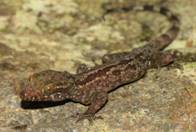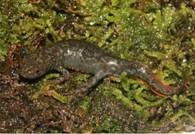Dr. Jing Che, Principal Investigator. Using amphibian and reptile as model, we often explore the biodiversity issue and evolutionary questions within a phylogenetic framework mostly concentrating on species inhabiting three regions: China’s Qinghai-Tibetan Plateau and Hengduan Mountain Range, Southeast Asia, and the mainland of East China and nearby islands.
Email: chej@mail.kiz.ac.cn
1. River islands, refugia and genetic structuring in the endemic brown frog Rana kukunoris of the Qinghai-Tibetan Plateau
Typically, species distributed on the Qinghai-Tibetan plateau have been hypothesized to re-treat to south-eastern refugia. We studied the phylogeography of the wood frog distributed in northeastern margin of plateau, which showed different evolutionary pattern. There are several glacial refuge in the northeast edge of the Tibetan Plateau and the northern Qilian Mountains. “River islands” was first proposed to explain the populations distributed in northern Qilian Mountains. These populations were highly differentiated and isolated by inland rivers. These results were found to have important implications for the habitat conservation in Northwest China.(Zhou et al. 2013).
2. Geological events play a larger role than Pleistocene climatic fluctuations in driving the genetic structure of Quasipaa boulengeri
Paleoclimatic and paleogeological events have been identified as being the two main drivers of genetic structuring in extant organisms. We used a montane stream-dwelling frog, Quasipaa boulengeri, to explore the relative roles played by these drivers on species in southern China, a region needing thorough studies. Analyses identified geological events as playing a larger role than climatic fluctuations in driving the population history of Q. boulengeri. The unification of the upper and middle Yangtze River in the Three Gorges mountain region mediated downstream colonization of this frog. (Yan et al. 2013)
3. High cryptic biodiversity in Amphibians was explored based on the DNA barcoding
Based on DNA barcoding, a large of cryptic diversity in amphibian was suggested. Five new species here were described.
1) Leptolalax zhangyapingi (Jiang et al 2013), distributed in Chiang Mai, northern Thailand; 2) Cyrtodactylus phuocbinhensis and Cyrtodactylus taynguyenensis (Nguyen et al 2013), distributed in Vietnam; 3) Cynops glaucus (Yuan et al 2013), distributed in Guangdong; 4) Protobothrops himalayanus (Pan et al 2013), distributed in Tibet.


New species
Cyrtodactylus phuocbinhensis New species Cynops glaucus
Publications in 2013
1. Zhou WW, Yan F, Fu J, Wu SF, Murphy RW, Che J*, Zhang YP*. 2013. River islands, refugia, and genetic structuring in the endemic brown frog Rana kukunoris (Anura, Ranidae) of
the Qinghai-Tibetan Plateau. Molecular Ecology, 22: 130-142.
2. Yan F, Zhou WW, Zhao HT, Yuan ZY, Wang YY, Jiang K, Jin JQ, Murphy RW, Che J*, Zhang YP*. 2013. Geological events play a larger role than Pleistocene climatic fluctuations in the genetic structure of the montane stream-dwelling frog Quasipaa boulengeri (Anura: Dicroglossidae) in southern China. Molecular Ecology, 22(4): 1120-1133.
3. Murphy RW*, Crawford AJ, Bauer AM, Che J, Donnellan SC, Fritz U, Haddad CFB, Nagy ZT, Poyarkov NA, Vences M, Wang WZ, Zhang YP. 2013. Cold Code: the global initiative to DNA barcode amphibians and nonavian reptiles. Molecular Ecology Resources, 13(2): 161-167.
4. Nguyen SN, Le TNT, Tran TAD, Orlov NL, Lathrop A, Macculloch RD, Le TDT, Jin JQ, Nguyen LT, Nguyen TT, Hoang DD, Che J*, Murphy RW*, Zhang YP*. 2013. Phylogeny of the Cyrtodactylus irregularis species complex (Squamata: Gekkonidae) from Vietnam with the description of two new species. Zootaxa, 3737(4): 399-414.
5. Jiang K, Yan F, Suwannapoom C, Chomdej S, Che J*. 2013. A new species of the genus Leptolalax (Anura: Megophryidae) from northern Thailand. Asian Herpetological Research. 4(2) : 100-108.
6. Yuan ZY, Jiang K, Ding LM, Zhang L, Che J*. 2013. A New Newt of the Genus Cynops (Caudata: Salamandridae) from Guangdong, China. Asian Herpetological Research. 4(2) : 116-123.
(* corresponding author)
Staff
Weiwei Zhou, Associate Professor
Yanbo Sun, Associate Professor
Fang Yan, Assistant Professor
Jieqiong Jin, Technician
Hongman Chen, Assistant Engineer
Graduate Students
Zhiyong Yuan, 2010; Xiaolong Tu, 2011; Wei Gao, 2012; Tingting Fu, 2013
Jie Liu, 2009; Junxiao Yang, 2010; Yong Shao, 2011; Baolin Zhang, 2012; Jinmin Chen, 2012
